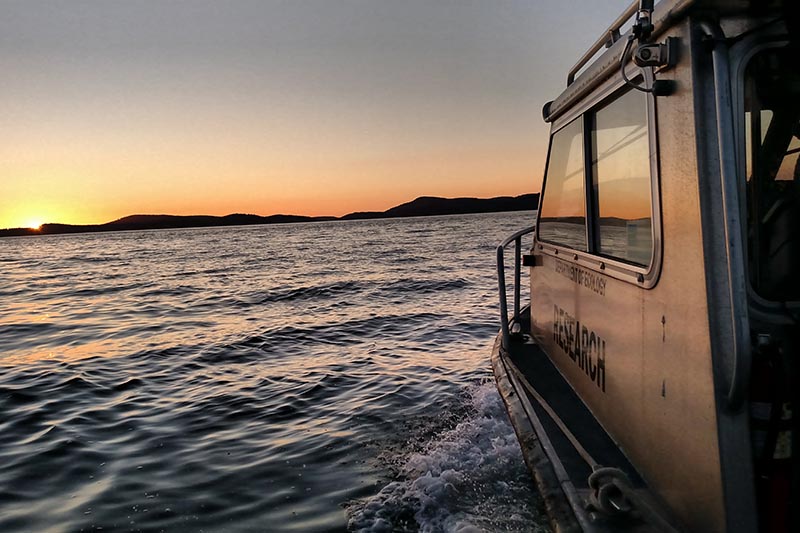Toxic chemicals in Puget Sound
Much of the pollution that enters the environment comes from the small but steady release of toxic chemicals contained in everyday products, such as brakes on cars, flame retardants in furniture, softeners in plastics, and building and roofing materials. As products are used and disposed, the toxics they contain can enter rivers, streams, lakes, and Puget Sound.
Exposure to these toxic chemicals can cause harm to human health and the animals exposed to them in the environment. Infants and children are especially at risk. Some toxic chemicals impair development, some affect reproduction and disrupt body chemistry, and some cause cancer. Known as persistent bioaccumlative and toxic chemicals (PBTs), they can linger in the environment for decades and be found in the fatty tissue of people and animals long after their use has been stopped or products banned.
Our toxics efforts focus on identifying priority toxic chemicals and developing plans to reduce or eliminate their use, or to mitigate their impacts on people and the environment. Our approach is:
- Prevention: Reduce the use of toxic materials and prevent them from entering into use in homes and industry.
- Management: Clean up contaminated water bodies with source control planning efforts.
- Research: Use monitoring data to inform decisions and prioritize actions.
Studying how toxics get into Puget Sound
- Surface runoff
- Groundwater
- Ocean exchange
- Wastewater treatment plants
- Atmospheric deposition
Puget Sound Toxics Assessment
We assessed selected toxic chemicals in 2011. A long-term study outlined the loading pathways, estimated volumes coming from various sources, and provided technical information to help develop toxic-chemical-control strategies for the Puget Sound basin.Toxics projects 2011 - 2018
Roughly $10.6 million of a $21 million federal National Estuary Program grant in 2011 provided investments for pollution prevention, management of toxic chemicals, and research on Puget Sound toxics through 2018, based on the Toxics Assessment recommendations. A report outlining these projects — including successes, challenges, and recommendations for further work — is available.Surface runoff most common pollutant pathway
The most common delivery pathway toxic chemicals take to reach Puget Sound is through polluted surface runoff — also known as stormwater. Rain hits roofs, roads, developed areas, and other hard surfaces and runs into storm drains. It then goes mostly untreated into lakes, streams, and rivers that drain to Puget Sound.The highest concentrations of toxic pollutants come from developed areas of residential, commercial/industrial, and agricultural land uses. These types of land uses have a large amount of impervious surfaces, like pavement and roofs that prevent rainwater from soaking directly into the ground. This creates the conditions for these chemicals to be carried away in runoff.
Targeted chemicals of concern
Scientists assessed the relative hazards posed by target chemicals in the assessment report. Results of the hazard evaluation suggest that the following chemicals are most likely to be found at concentrations of concern:- Copper, used in brake pads and boat paints.
- Mercury from fluorescent light bulbs, dental fillings, and other sources.
- Polychlorinated biphenyls (PCBs), from legacy products and some current paints and dyes.
- Polychlorinated dioxins and furans (PCDD/Fs), compounds formed during combustion.
- The pesticide DDT (and its metabolites DDD and DDE).
- Polycyclic aromatic hydrocarbons (PAHs) from petroleum, creosote, and wood combustion.
- Bis(2-ethylhexyl) phthalate (DEHP), a plastic additive.
Other chemicals studied in the assessment, such as PBDEs and many that have yet to be studied, are also present at levels of concern, but hazard thresholds for most compounds are lacking.
Ongoing monitoring of toxic chemical sources
Other studies describe toxics in the Sound
- Puget Sound Regional Toxics Model: Evaluation of PCBs, PBDEs, PAHs, Copper, Lead, and Zinc
- Sediment Quality in Urban Bays describes studies of chemical contaminants at the bottom of Puget Sound.
- The North Olympic Peninsula Regional Background Study looks at background levels of contaminants in marine sediments of the north Olympic Peninsula, from Port Angeles to Port Townsend.
- Our partners at Washington Fish and Wildlife’s T-BiOS routinely sample Puget Sound biota for toxics, informing the Puget Sound Partnership’s Toxics in Aquatic Life Vital Sign by providing key recovery metrics.


